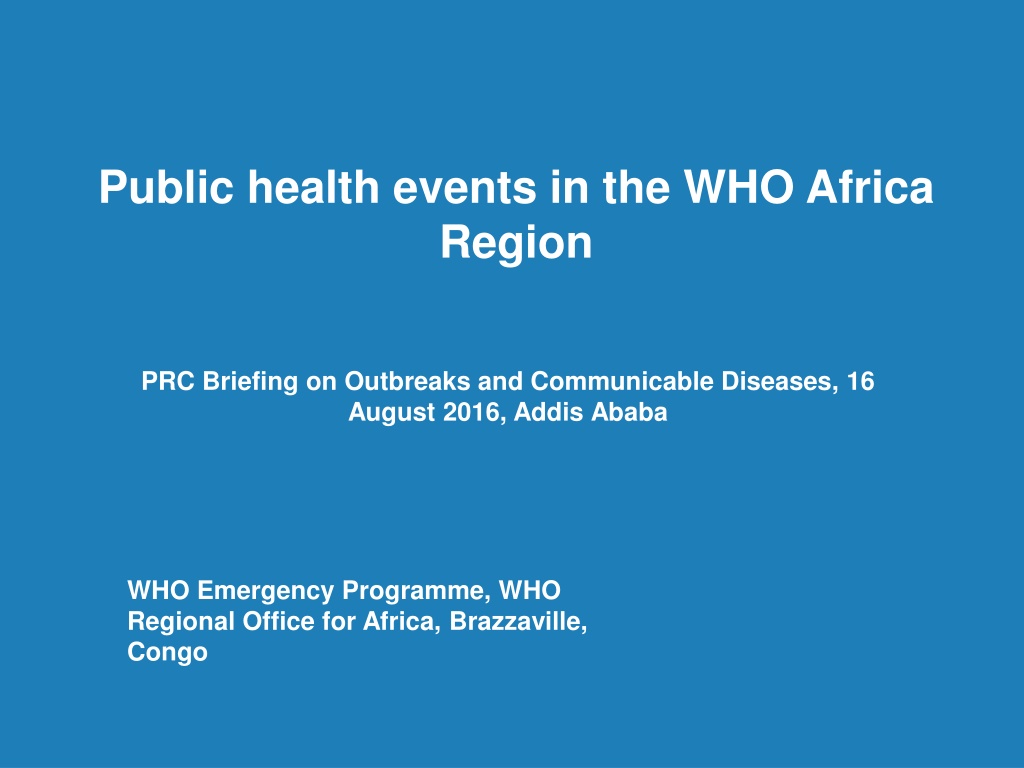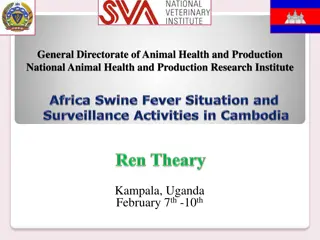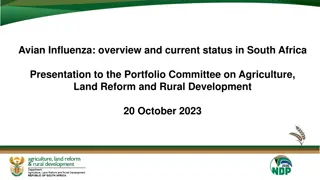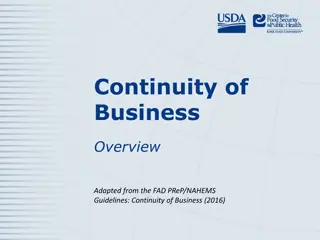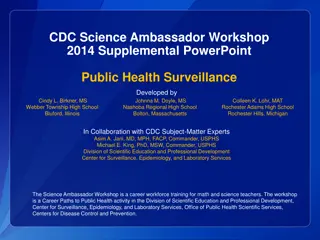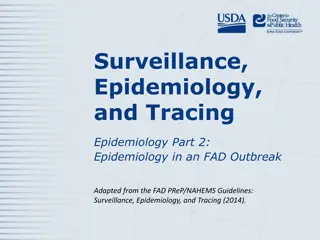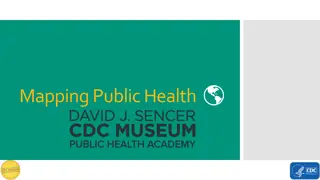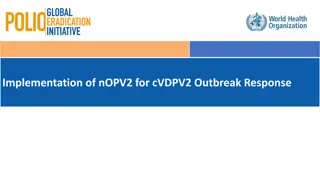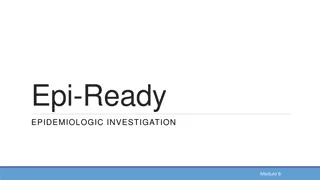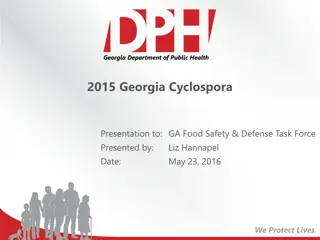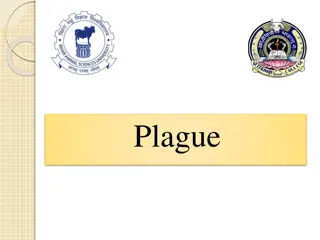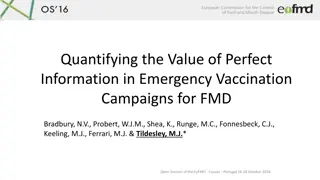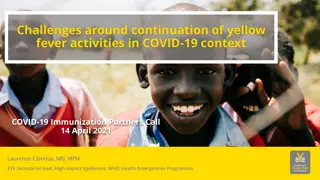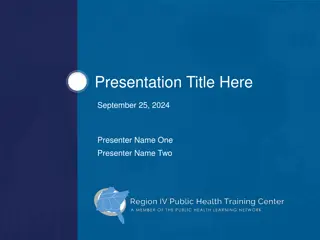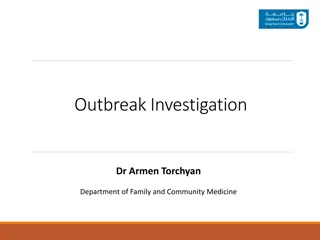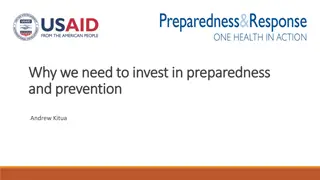Public Health Events in WHO Africa Region: Outbreaks Overview
Public health events in the WHO Africa Region pose a significant threat to global health security, with frequent outbreaks of diseases like Ebola, Yellow Fever, Polio, and cholera. In 2015, 105 public health events were reported, the majority being infectious diseases. Ongoing outbreaks in Angola, DR Congo, and Uganda highlight the urgency for effective response and containment strategies.
Download Presentation

Please find below an Image/Link to download the presentation.
The content on the website is provided AS IS for your information and personal use only. It may not be sold, licensed, or shared on other websites without obtaining consent from the author. Download presentation by click this link. If you encounter any issues during the download, it is possible that the publisher has removed the file from their server.
E N D
Presentation Transcript
Public health events in the WHO Africa Region PRC Briefing on Outbreaks and Communicable Diseases, 16 August 2016, Addis Ababa WHO Emergency Programme, WHO Regional Office for Africa, Brazzaville, Congo
Overview of reported PHEs in WHO African region Outbreaks & other health emergencies are frequent in the WHO African region PHEs e.g. Ebola, YF, Polio, Zika, cholera threaten regional and global health security Disrupts societies and economies About 100 acute public health events occur annually in the African Region In 2015, 105 Public health events were reported. Over 60 emergencies reported from 30 countries this year alone
2015: public health events 82 (78%): Infectious diseases 18 (17%): Disaster 4 (4%): Chemical
Yellow Fever -Angola YF outbreak in Angola is largest in recent decades As of 29th July, a total of 3,818 suspected cases have been reported of which 879 were laboratory confirmed 369 deaths (CFR =10%) among all suspected cases and 118 deaths (CFR =13.4%) among the confirmed cases Laboratory confirmed cases have been reported in all the 18 provinces and in 79 out of 123 districts. Luanda province has the majority of the confirmed cases 489 (56.8%), followed by Huambo 127 (17.7%) and Benguela 111 (12.9%)
Yellow Fever-DR Congo On June 20th 2016, the Minister of health made an official statement declaring the YF outbreak a health emergency in the DRC Five new cases of yellow fever were laboratory confirmed between 16 and 20 June 2016. Cases were reported from Kisenso, Masina II in Kinshasa and Matadi (1 and Muanda in Kongo Central. As of June 19, 2016 , a total of 68 confirmed cases of yellow fever have been notified, with seven (7) indigenous cases. Daily notification of suspected cases of yellow fever is continuing
Yellow Fever-Uganda The outbreak in Uganda was notified on 9 April 2016 As of 8 Jun 2016, a total of 91 cases including 3 deaths had been reported with 7 confirmed cases in three districts- Masaka (5), Rukungiri (1) and Kalangala (1)) districts Sequencing showed a high similarity with the YF outbreak in 2010 in Northern Uganda Uganda quickly responded and initiated reactive mass vaccination campaigns in the three districts achieving a coverage of 90.6% -96.8% in less than two weeks
Cholera Fifteen countries reported a cumulative total of 97,472 cases and 1,936 deaths during the period January 2015 to 3 August 2016 Between January 4 August 2016, a total over 30,000 cases and 400 deaths were reported in 14 out of 47 member states Three countries accounted for 84% of all cases; DRC (35%, CFR 2%), Tanzania (30%, CFR 1.5%), and Kenya (19%, CFR 1.3%) Humanitarian crises in CAR, South Sudan and Burundi associated with displacement of thousands of people have resulted in major health consequences Floods and El nino affecting millions of people in eastern and Southern Africa including; Ethiopia, Zimbabwe, Malawi, Lesotho, South Africa and Zambia
Countries that reported cholera outbreaks to WHO January 2015 to 3 August 2016 Time period Country Area (s) Cases Deaths CFR (%) Aguegues, So-Aya 94 0 0.0 17 Feb-Apr 16 Benin Nationwide, endemic spread to 7 new provinces (Lualaba, Maniema, Tshopo, Kinshasa, Mongala, Equateur, and Maindombe) Oromia, Somali, Addis, SNNP, Afar, Amhara 33,992 653 1.9 Jan 15 24 July 16 DRC 9,155 49 0.5 6 Nov 15- 31 July 16 Ethiopia Nationwide, 2 counties active; Tana river and Mandera 16,585 254 1.5 Jun 15-4 July 16 Kenya Blantyre, Karonga, Kasungu, Lilongwe, Machinga, Mangochi, Mchinji, Nkhata Bay, Phalombe, Zomba 1643 43 2.6 18Dec 15-20May 16 Malawi Nampula, Niassa, Zambezia 1433 8 0.6 Aug 15-Jan 16 Mozambique Borno, Jigawa, Kano 1241 19 1.5 7Sept 15-Apr 16 Nigeria Banadir, Bay, Lower and middle Juba, Lower and middle Shabelle, & Hiraan 7343 366 5.0 Jan 15-April 16 Somalia Juba, Terekeka, and Duk counties in central Equatoria and Jonglei states 679 21 3.1 June 2015 - 1 August 16 S. Sudan Nationwide; 2 regions active, Morogoro and Zanzibar island 22,385 346 1.5 21Aug 15-3 August 16 Tanzania Arua, Busia, Hoima, Kampala, Kasese, Mbale, Moroto, Sironko, Wakiso, 1583 148 9.3 Oct15-Feb16 Uganda Lusaka, Central, Northern, Southern provinces 1339 29 2.2 4Feb-15Jun 16 Zambia Total 97,472 1936
Cholera Response WHO and partners provide support to Ministries of Health in areas of; Coordination Surveillance including laboratory service Case management Logistics and supplies WASH and social mobilization Emphasis on multi-sectoral and multi-agency approach to effectively address causes of cholera outbreaks, often linked to; Unsafe water, Poor food hygiene, Poor sanitation Overall decline in trends in a number of countries including Mozambique, Malawi, Zambia, Tanzania. These gains need to be sustained
Issues in cholera response Low multi-sectoral and multi-agency involvement to effectively address root causes of cholera and other water borne diseases outside mandate of Health Water and sanitation Food hygiene Weak surveillance systems for early detection, confirmation and effective response to cholera outbreaks Weak monitoring and evaluation system
Priority Actions -Cholera-1 Strengthen and sustain capacity of member states through a Regional strategy; Prevent outbreaks and other health emergencies Reduce morbidity, mortality, disability and socio-economic disruptions due to PHEs including cholera by prompt; detection and confirmation of outbreaks Response to and recovery from negative effects of PHEs High level advocacy for strong multi-sectoral and multi- agency strategy to effectively address root causes of cholera and other water borne diseases (water & sanitation, Food hygiene)
Priority Actions -Cholera-2 Conduct joint process reviews to assess bottlenecks to cholera outbreak response Countries where cholera outbreaks have been controlled, need to conduct after-outbreak response review to identify lessons learnt and best practices, risk profiling using the all hazard approach and review contingency plans accordingly Maintain cholera as standing item on the Multi-sectoral national and provincial/district outbreak response committees monthly meetings Cholera preparedness plans should be implemented 1-2 months before onset of another season Need for strong monitoring and evaluation system and use of data for action
Chikungunya-Kenya Started in the 1st week of May 2016 MOH reported to WHO on 28 May 2016 As of 14 June 2016, 1,394 cases with 0 death had been reported from the Mandera County Of the 82 samples tested, 25 were positive for Chikungunya virus by KEMRI Arboviral laboratory in Nairobi 14 Title of the Presentation
We need a regional strategy to guide member states & partners Vision: A safer African region where outbreaks and disasters are no longer major causes of morbidity and mortality and socio-economic disruption Mission: Support MS to ensure health security through prevention, prediction, early warning, early detection, and, rapid and effective response emergencies and disasters including disease outbreaks, using an all-hazard approach linked to primary health care systems. Goal: To minimize the public health and socio-economic impact of outbreaks, emergencies and disasters, in the African Region
Objectives To strengthen and sustain the capacity of all the Member States health systems to prevent outbreaks and other health emergencies To strengthen and sustain the capacity of all the Member States health systems to promptly detect and confirm outbreaks To strengthen and sustain the capacity of all the Member States health systems to promptly respond to and recover from the negative effects of outbreaks and health emergencies
Targets -1 At least 80%, of Member States have organized a joint external evaluation (JEE) of IHR core capacities by 2018. At least 80%, of Member States have all hazards preparedness plans that are reviewed and tested, by 2018. At least, 80% of the Member States will have the minimum IHR core capacities, by 2020. Over 90%, of Member States are implementing IDSR including event-based surveillance systems with at least 90% country coverage, by 2020. At least 80% of Member States have a functional national laboratory system and network by 2020
Targets-2 Over 90% of Member States have a multi-level and multi-faced risk communication strategy for real time exchange of information, by 2020. Over 80% of Member States will have an adequate health work force to respond to outbreaks and health emergencies as stipulated in the JEE tool by 2020
Strategic Approaches All-hazard approach one operational platform , One Health, new WHE The RAPID concept: Rapid response for rapid impact Actions and results oriented Proactive Preparedness and Prevention Intelligence and real-time information, risk mapping and communication for rapid decision making Dedicated staff and team including across clusters
Priority Strategic actions-1 Conduct regional risk-mapping for PHEs to build early warning and response systems Establish management for decision making regional capacity for strategic information AMR surveillance and mitigation High level advocacy meetings for IHR including other sectors in collaboration with RECs Revitalize African Public Health Fund Build country IHR core capacities in a coordinated manner in the context of GHS-better partners 'coordination
Priority Strategic actions-2 Implementation of the one health approach and AMR; advocacy for improved stock pile of vaccines-YF, meningitis, OCV Strengthening IHR core capacities in low and middle income countries linked to district health system strengthening Early warning system, district and community surveillance using eSurveillance and real-time information Building laboratory capacities, biosafety and strengthening of Infection Prevention and Control (IPC) - Experts deployment during emergencies
Partnerships, Collaboration & Advocacy Enhanced advocacy for IHR & GHS capacity building in context of WHO emergency reform Establish a regional partnership forum for One health to serve as a platform for coordinated action, mobilizing resources and forging consensus among partners and Member States Facilitate partnerships to improve preparedness, alert and response and strengthen cross-country and cross-institutional collaboration. Strengthen national and regional networks of Research Institutes to support Member States to conduct research Establish a regional health workforce to promptly respond to outbreaks and health emergencies. Collaboration with the Africa CDC and coordination of new initiatives
What the world expects of WHO in emergencies? 1 Single approach for all emergencies (outbreaks, disasters, etc) 2 Standardized across all 3 levels & all 7 major offices 3 Leverage & facilitate UN, partners & disaster mgmt systems 4 Optimize WHO political access & technical expertise Operate across the emergency management cycle 5
WHOs new Health Emergencies Programme One emergency programme 'A quicker, predictable, dependable, & capable WHO in support of people at risk of, or affected by, emergencies' One workforce One budget One line of accountability One set of processes/systems One set of benchmarks
All hazards approach Event Hazard Chemical Spill Radiation Leak RESPONSE Infectious risk grading & mgmt Infectious Hazards (e.g H5N1, H7N9, coronaviruses, filoviruses) Event Grading & Response Infectious Outbreak Natural disaster Event Conflict War Infectious Hazard Managment Emergency operations
WHO's Roles in Health Emergency Risk Management Infectious Hazard Management IHR & Member State Preparedness Risk Assessment & Health Emergency Info/Data Emergency Operations Incident management Protracted crises planning Operational Partners & Readiness Operations Support & Logistics 27
A financially empowered & sustainable WHO Health Emergencies Programme Adequate financing is a prerequisite for success in supporting of Member State preparedness strengthening The financial viability and sustainability of the new programme requires a combination of core financing for WHO s standing emergency risk management capacity and normative work Also required is a contingency fund (CFE) for rapidly initiating and enabling new emergency response operations
Conclusion We need to collectively act now to stop the loss of African lives We need robust surveillance to nip epidemics and health emergencies in the bud We need to build world class infrastructure to prevent, detect, and respond to outbreaks and other health emergencies New WHE programme offers us an opportunity
Thank You 30 Title of the Presentation
